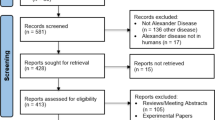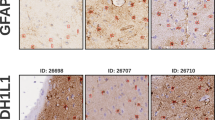Abstract
Alexander disease is a leukodystrophy that is neuropathologically characterized by the presence of numerous Rosenthal fibers in astrocytes. Recently, mutations in the gene encoding glial fibrillary acidic protein (GFAP) were identified in patients with Alexander disease. We sequenced the GFAP gene of a Japanese girl who presented with typical symptoms of Alexander disease but in whom the diagnosis was not proven by histopathology. We identified a missense mutation, R239C, which is identical to the mutation previously reported to be most frequent. As was the case in previously described patients, our patient was also heterozygous for the de novo mutation. Interestingly, despite the fact that this is a de novo mutation, R239C was found to be common in different ethnic groups, implying that the site is a "hot spot" for mutagenesis. Molecular genetic analysis now makes the antemortem diagnosis of Alexander disease possible.
Similar content being viewed by others
Log in or create a free account to read this content
Gain free access to this article, as well as selected content from this journal and more on nature.com
or
Author information
Authors and Affiliations
Additional information
Received: June 4, 2001 / Accepted: July 13, 2001
Rights and permissions
About this article
Cite this article
Shiroma, N., Kanazawa, N., Izumi, M. et al. Diagnosis of Alexander disease in a Japanese patient by molecular genetic analysis. J Hum Genet 46, 579–582 (2001). https://doi.org/10.1007/s100380170024
Issue date:
DOI: https://doi.org/10.1007/s100380170024



